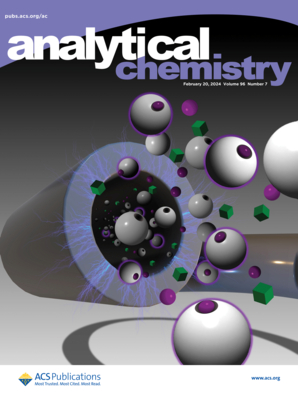单细胞5 μm分辨率双极性MALDI-MS成像,无需重新应用矩阵。
IF 6.7
1区 化学
Q1 CHEMISTRY, ANALYTICAL
引用次数: 0
摘要
高分辨率质谱成像(MSI)在脂质组学中起着至关重要的作用,但由于空间分辨率和脂质覆盖范围的限制,在单细胞水平上分析脂质仍然存在挑战。虽然现有的基于单基质应用步骤的双极性策略提供了相同样品的高脂质覆盖率,并且易于样品制备,但基质耗尽将其空间分辨率限制在10 μm,阻碍了它们在单细胞成像中的应用。在这里,我们提出了一种单细胞/亚细胞分辨率策略,用于双极性基质辅助激光解吸和电离质谱成像(MALDI-MSI),消除了对基质重新应用的需要。该方法可实现5 μm的空间分辨率,同时保持与多步单细胞成像方法相当的脂质覆盖率。这是通过微调的基质沉积技术实现的,该技术充分利用了N-(1-萘基)-二盐酸乙二胺(NEDC)在双极性和优化的采集条件下的高灵敏度,允许单次沉积工作流程,无需洗涤,重新制备或图像重新校准。这种单细胞分辨率MALDI-MSI策略成功地成像了小鼠肾组织和肺癌细胞中具有独特空间细节的更广泛的脂质种类(A549)。利用空间概率潜在语义分析(PLSA),我们确定了单细胞群体中两极性的三种不同的脂质分布模式,直方图分析揭示了细胞间脂质组学的异质性。该策略克服了传统双极性MSI的局限性,为推进细胞脂质组学、阐明疾病机制和研究环境毒理学提供了强有力的工具。本文章由计算机程序翻译,如有差异,请以英文原文为准。
Single-Cell 5 μm-Resolution Dual-Polarity MALDI-MS Imaging without Matrix Reapplication.
High-resolution mass spectrometry imaging (MSI) plays a vital role in lipidomics, yet challenges persist in analyzing lipids at the single-cell level due to limitations in spatial resolution and lipid coverage. While existing strategies based on a single matrix application step for dual-polarity provide high lipid coverage from the same sample and enable easy sample preparation, matrix depletion limits their spatial resolution to 10 μm, preventing their application to single-cell imaging. Here, we present a single-cell/subcellular resolution strategy for dual-polarity matrix-assisted laser desorption and ionization mass spectrometry imaging (MALDI-MSI) that eliminates the need for matrix reapplication. This approach achieves 5 μm spatial resolution while maintaining lipid coverage comparable to multistep single-cell imaging methods. This is enabled by a fine-tuned matrix deposition technique that fully utilizes the high sensitivity of N-(1-naphthyl)-ethylenediamine dihydrochloride (NEDC) in dual polarities and optimized acquisition conditions, allowing single-deposition workflows without the need for washing, repreparation, or image recalibration. This single-cell resolution MALDI-MSI strategy successfully imaged a broader range of lipid species with distinctive spatial detail in mouse kidney tissue and lung carcinoma cells (A549). Using spatial probabilistic latent semantic analysis (PLSA), we identified three distinct lipid distribution patterns within a single-cell population in both polarities, and histogram analysis revealed substantial cell-to-cell lipidomic heterogeneity. This strategy overcomes limitations of traditional dual-polarity MSI and provides a powerful tool for advancing cellular lipidomics, elucidating disease mechanisms, and investigating environmental toxicology.
求助全文
通过发布文献求助,成功后即可免费获取论文全文。
去求助
来源期刊

Analytical Chemistry
化学-分析化学
CiteScore
12.10
自引率
12.20%
发文量
1949
审稿时长
1.4 months
期刊介绍:
Analytical Chemistry, a peer-reviewed research journal, focuses on disseminating new and original knowledge across all branches of analytical chemistry. Fundamental articles may explore general principles of chemical measurement science and need not directly address existing or potential analytical methodology. They can be entirely theoretical or report experimental results. Contributions may cover various phases of analytical operations, including sampling, bioanalysis, electrochemistry, mass spectrometry, microscale and nanoscale systems, environmental analysis, separations, spectroscopy, chemical reactions and selectivity, instrumentation, imaging, surface analysis, and data processing. Papers discussing known analytical methods should present a significant, original application of the method, a notable improvement, or results on an important analyte.
 求助内容:
求助内容: 应助结果提醒方式:
应助结果提醒方式:


